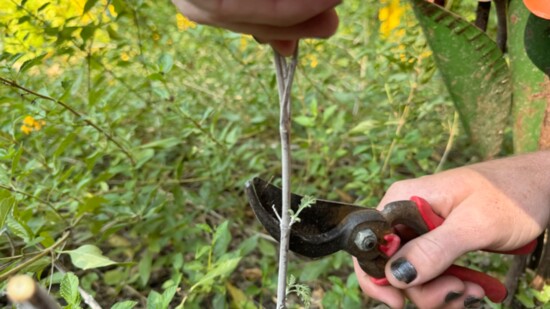Fall pruning
-
Encourage spring growth: Removing dead or damaged branches allows plants to focus on new growth when spring arrives.
-
Prevent disease: Cutting back diseased branches reduces the risk of pathogens that can thrive in cool, moist conditions. Spotting distinct discolored spots or patterns on foliage is a good first indicator that disease may be present in your garden.
-
Minimize storm damage: Thinning out top-heavy plants prevents winter storm damage to plants and property.
What should be pruned?
-
Perennials: Trim spent bloom spikes on perennials, such as salvias, after their fall bloom to promote growth next season.
-
Dead/diseased branches: Remove these from shrubs and trees, such as Texas Sage and Live Oaks, to avoid winter pests and disease.
-
Overgrown shrubs: Prune shrubs, such as boxwood, hydrangeas and roses, to maintain their shape and airflow.
-
Fruit trees: Fall is the time to thin out dead or crowded branches to improve structure and fruit production.
Pruning techniques
-
Use sharp tools: Clean cuts with sanitized, sharp shears to prevent disease. To sanitize your tools, use 70% isopropyl alcohol and a cotton swab or cloth to carefully wipe both sides of the blades.
-
Cut at a 45-degree angle: This promotes drainage and healthy growth.
-
Don’t over-prune: Limit pruning to one-third of the plant to maintain its health during dormancy.
What not to prune
-
Spring-blooming shrubs: Avoid heavy pruning on salvias, lantanas and evergreens such as junipers, as it can increase cold damage.
-
Ornamental grasses: Leave these intact for winter structure and wildlife benefits.
Post-pruning care
-
Mulch: Insulate roots by adding mulch around pruned plants.
-
Watering: Give your plants a deep watering before the first freeze to protect their roots. Air freezes faster than water, so moist soil can help prevent frost damage to roots. Best practice is to allow a hose to rest at the base of a plant on a slow trickle for about 30 minutes to ensure the water penetrates the soil and does not run off.
-
Protect vulnerable plants: Use burlap wraps or frost protection blankets to shield tender plants from harsh winter winds. Tender plants can be anything from newly installed plants from your fall planting to plants that maintain moisture in their foliage, such as ghost plant, gopher plant and agave. It is best not to keep the insulations on longer than three to four days as this can prevent sunlight from reaching your plant. On the warmer days between freezing temperatures, be sure to remove the insulations to allow for sunlight to reach your plants.
With proper pruning and care, your garden will thrive and be ready for a lush spring.
For more gardening tips, visit floralandscape.studio/winterpruningguide.
